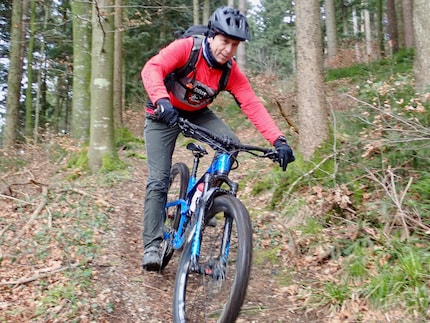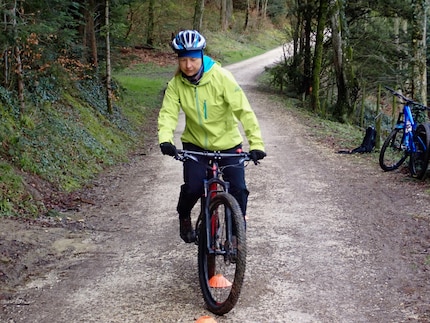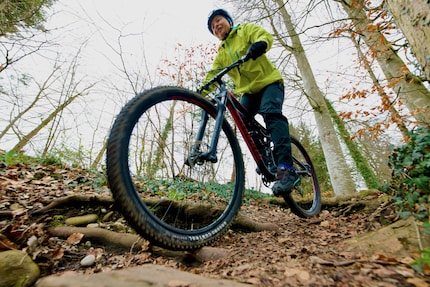
Opinion
30 years in the saddle: from bicycle to mountain bike
by Patrick Bardelli

«Everyone can do it, you definitely don’t need to do a course on it.» I keep hearing statements like this. But learning from experts is an effective shortcut to gaining better skills. And a mountain bike course is a good example of this.
For around ten years I was happy with my Hilite Bikes 26-inch mountain bike and its carbon frame. I liked the feel and manoeuvrability of the hardtail. But sometimes it was too sporty for me, especially on single trails full of stones and roots. I felt the need to ride more cautiously than necessary and avoided some trails altogether.
When I switched to a full-suspension 29-inch bike from Specialized at the beginning of the year, I thought this was the perfect opportunity to brush up on my skills. That’s why I booked a basic MTB course at the Swiss Bike School.
Swiss Bike School instructor Peter Lütolf has competed in various bike races himself, particularly in cross-country and marathon disciplines. He’s already received a finisher’s medal three times in 24-hour races and has also successfully completed the Tortour multiday gravel race three times. It was clear from the start that I’d learn a lot from him. What, exactly? Read on to find out.

People always think of their legs when they talk about biking. Yet, torso stability is equally important but often neglected. During basic exercises such as racing around small plastic cones or a short slalom course, Peter reminded me multiple times to: «Think about your hips.» In fact, turning was much easier when I used the right hip swing and body rotation. Pleasant abdominal muscle ache the next day indicated I was using deeper abdominal and core muscles which had previously been in a deep sleep when biking.

Practice makes perfect, as the saying goes. But that’s not true. Because if you’re always using a bad technique, you don’t get better, your errors just become habit. This was the case for me when riding uphill on trails with roots or gravel. I unconsciously shifted too much of my weight onto the front wheel. This would loosen the grip on the rear wheel and I slipped. This happened again and again. Until Peter pointed it out to me. Just like that, I was easily able to climb the section I’d previously tried to conquer with muscle power, without any problems. A small tip and changing my position by a few centimetres felt more effective than weeks of leg strength training.
Safety is perhaps the most obvious reason to take an MTB course. Because most mountain bikers don’t practice the skills they need to react quickly in a tricky situation. In my case, this included emergency braking on gravel. It’s great to see and feel what it takes to come to a stop without my rear wheel overtaking me or coming dangerously close to going over my handlebars. Knowing that I can stop quickly if something unexpected happens gives me confidence and more enjoyment when riding at speed.
The second exercise I loved was the dismounting behind the bike. I’d already tried this a few times for fun, but never got it to work smoothly. This technique is important if, for example, an obstacle, such as a fallen tree, suddenly appears behind a bend in the trail. After a few attempts and a crucial tip from Peter, I suddenly dismounted the saddle as safely as if I had always done it this way.
Having the bike under control always means being able to ride with consideration. If I can accelerate, slow down and steer my bike in the right direction at any time, even in tight spots, I can react to other people and animals on the trail in a more controlled way. To be honest, some of what is described as rowdy behaviour is simply a result of not mastering the technique.

As a teen and beyond, I thoroughly enjoyed taking part in competitive sports. And drills were always an important part of the training. Movement sequences are broken down into smaller steps and practised individually. Or movements that promote a specific skillset. Peter showed me a whole series of drills. For example, balancing the bike while the front tyre pushes against an obstacle. Or synchronising the pedal stroke with the downward pressure of the handlebars via the suspension so that I can make small jumps over stones and roots without much force. Or to attack corners so that the posture feels more natural and I can ride them more safely in the future.
My Garmin watch, the Fenix 6 Pro, shows me a whole range of data after exercise. In mountain biking, it also displays the flow value, i.e. a metric that shows how loose, efficient and relaxed I am on the bike. I still had a lot of room for improvement there. But even without the flow value, I notice at the end of the course: I’m more relaxed in the saddle, feel more content, have more fun on the bike and am proud to be able to apply what I’ve learned. I’ll definitely keep practising the drills and I’m already looking forward to another rewarding ab muscle ache. I’m also excited for the slightly more advanced trail course I’ll be taking in autumn.
Research diver, outdoor guide and SUP instructor – I love being in, on and around water. Lakes, rivers and the ocean are my playgrounds. For a change of perspective, I look at the world from above while trail running or flying drones.
This is a subjective opinion of the editorial team. It doesn't necessarily reflect the position of the company.
Show all